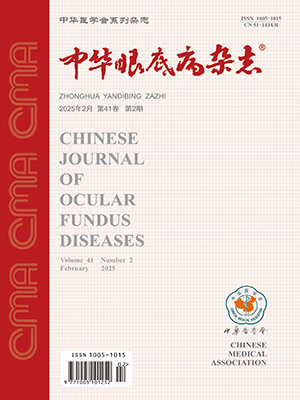| 1. |
Kwiterovich KA, Maguire MG, Murphy RP, et al. Frequency of adverse systemic reactions after fluorescein angiography. Results of a prospective study[J]. Ophthalmology, 1991, 98(7): 1139-1142.
|
| 2. |
Schwartz DM, Fingler J, Kim DY, et al. Phase-variance optical coherence tomography: a technique for noninvasive angiography[J]. Ophthalmology, 2014, 121(1): 180-187.DOI: 10.1016/j.ophtha.2013.09.002.
|
| 3. |
Jia Y, Tan O, Tokayer J, et al. Split-spectrum amplitude-decorrelation angiography with optical coherence tomography[J]. Opt Express, 2012, 20(4): 4710-4725. DOI: 10.1364/OE.20.004710.
|
| 4. |
Fleiss JL, Leein B, Paik MC. Statistical Methods for Rates and Proportions[M]. 3rd ed. Hoboken: John Wiley & Sons Inc. , 2003: 608-610.
|
| 5. |
Novotny HR, Alvis DL. A method of photographing fluorescence in circulating blood in the human retina[J]. Circulation, 1961, 24(1): 82-86.
|
| 6. |
Laatikainen L.The fluorescein angiography revolution: a breakthrough with sustained impact[J].Acta Ophthalmol Scand, 2004, 82(4): 381-392.
|
| 7. |
Ascaso FJ, Tiestos MT, Navales J, et al. Fatal acute myocardial infarction after intravenous flluorescein angiography[J]. Retina, 1993, 13(3): 238-239.
|
| 8. |
Weinhaus RS, Burke FC, Delori FC, et al. Comparison of fluorescein angiography with microvascular anatomy macoque retinas[J]. Exp Eye Res, 1995, 61(1): 1-16.
|
| 9. |
Teussink MM, Breukink MB, van Grinsven MJ, et al. OCT angiography compared to fluorescein and indocyanine green angiography in chronic central serous chorioretinopathy[J]. Invest Ophthalmol Vis Sci, 2015, 56(9): 5229-5237.DOI: 10.1167/iovs.15-17140.
|
| 10. |
Palejwala NV, Jia Y, Gao SS, et al. Detection of nonexudative choroidal neovascularization in age-related macular degeneration with optical coherence tomography angiography[J]. Retina, 2015, 35(11): 2204-2211.DOI: 10.1097/IAE.0000000000000867.
|
| 11. |
Yu J, Jiang CH, Sun XH, et al. Macular perfusion in healthy Chinese: a optical coherence tomography angiogram study[J]. Invest Ophthalmol Vis Sci, 2014, 56(5): 3212-3217.DOI: 10.1167/iovs.14-16270.
|
| 12. |
Moore J, Bagley S, Ireland G, et al. Three dimensional analysis of microaneurysms in the human diabetic retina[J]. J Anat, 1999, 194(1): 89-100.
|
| 13. |
Tan PE, Yu PK, Balaratnasingam C, et al. Quantitative confocal imaging of the retinal microvasculature in the human retina[J]. Invest Ophthalmol Vis Sci, 2012, 53(9): 5502-5514.DOI: 10.1167/iovs.12-10265.
|
| 14. |
Ishibazawa A, Nagaoka T, Takahashi, A, et al. Optical coherence tomography angiography in diabetic retinopathy: a prospective pilot study[J]. Am J Ophthalmol, 2015, 160(1): 35-44.DOI: 10.1016/j.ajo.2015.04.021.
|
| 15. |
Imai A, Toriyama Y, Iesato Y, et al. En face swept-source optical coherence tomography detecting thinning of inner retinal layers as an indicator of capillary nonperfusion[J]. Eur J Ophthalmol, 2015, 25(2): 153-158.DOI: 10.5301/ejo.5000514.
|




